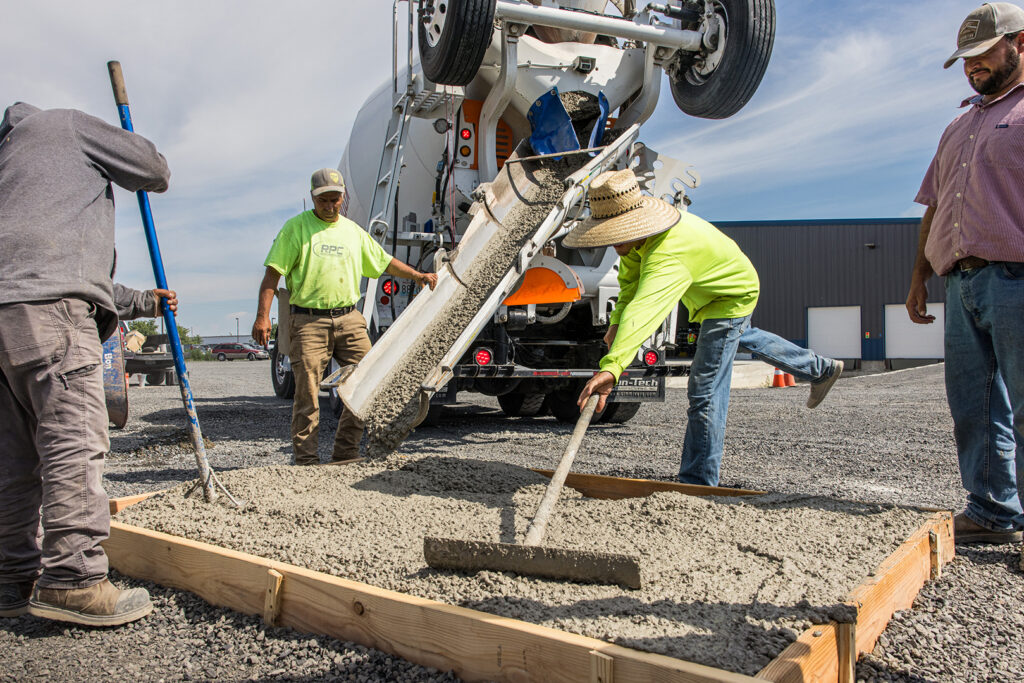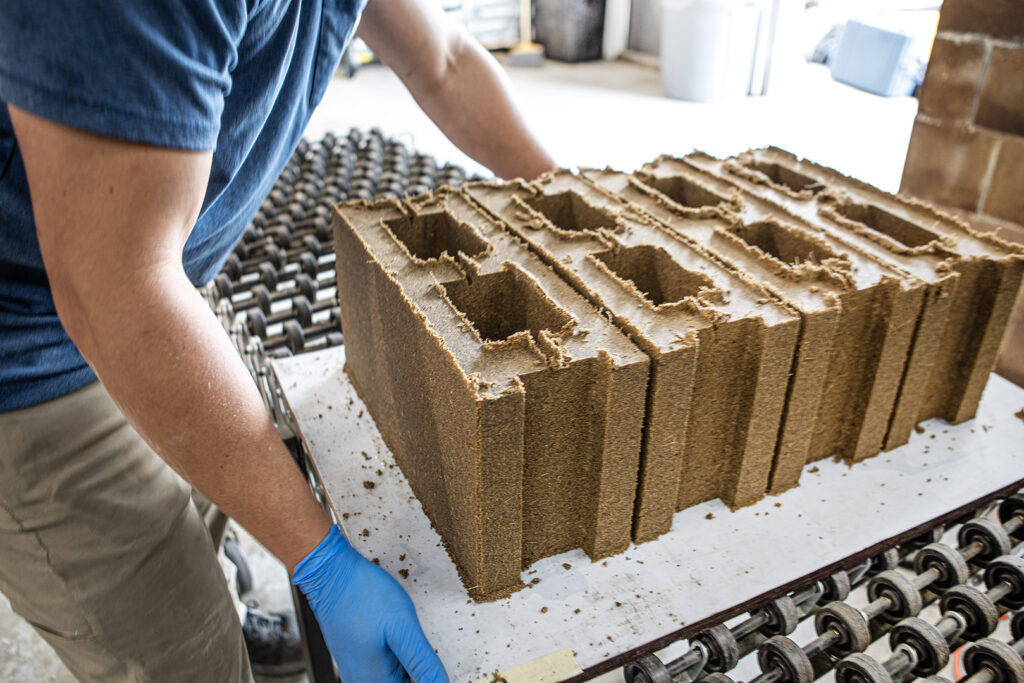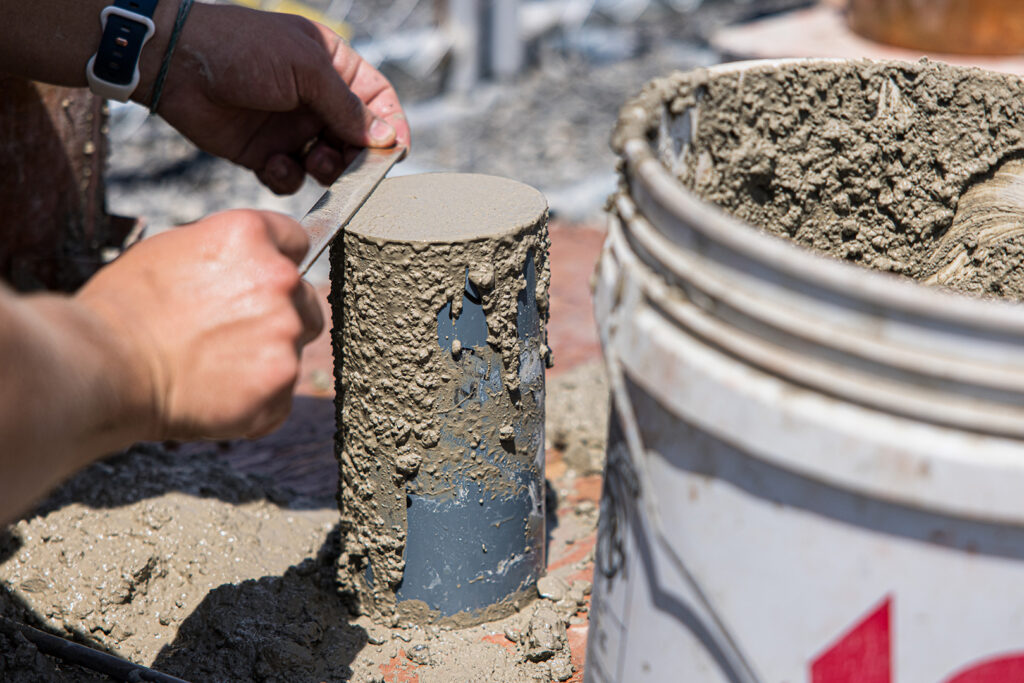Microsoft lays foundation for green building materials of tomorrow
Quincy, Washington – Crushed rock and sand banged around in the swirling drum of a concrete mixer truck here on a construction contractor’s lot adjacent to a Microsoft datacenter. The scene on this sweltering summer day marked another step in Microsoft’s journey to be carbon negative by 2030.
A team of concrete finishers stood at the ready to flatten and smooth the mixture that would tumble down the mixer-truck’s chute into one of three wooden frames roughly the size of a tabletop and harden to form concrete slabs.
The mixture in the drum, though, wasn’t typical. In addition to the rock, sand, water and cement usually found in concrete mixtures, it contained a limestone derived from microalgae and other additives that lower the overall embodied carbon in concrete.
Embodied carbon is a measure of the carbon emitted during the manufacturing, installation, maintenance and disposal of a product or material. The embodied carbon of concrete is currently responsible for around 8% of global greenhouse gas emissions, according to industry and government calculations. The embodied carbon in steel, another material used in heavy construction, accounts for an estimated 7% of carbon emissions.
“Within the built environment, decarbonization of concrete and steel is critically important from a climate impact perspective,” said Brandon Middaugh, the senior director of Microsoft’s Climate Innovation Fund, a $1 billion fund to accelerate the development and deployment of climate solutions.
A plan in action
Reducing or eliminating embodied carbon from concrete and steel is a challenge because the traditional processes used to manufacture them are carbon intensive, noted Sean James, senior director of datacenter research in Microsoft’s datacenter research team.
Overcoming that challenge with alternative, lower-embodied carbon materials, he said, will help Microsoft make progress towards its commitment to be carbon negative by 2030. It also has implications for the rest of the world where the global construction industry is currently on pace to construct a New York City’s worth of buildings every month for the next 37 years.
The bulk of emissions associated with concrete come from cement production, noted Steve Gilges, a principal infrastructure engineer on Microsoft’s datacenter research team. A key ingredient of cement is limestone, which is typically heated with clay to around 2,650 degrees Fahrenheit in a coal or gas-fired kiln where it undergoes a chemical reaction called calcination that releases carbon dioxide as a byproduct.
The concrete mixes piloted in Quincy include one with biogenic limestone, one with fly ash and slag that are activated with alkaline soda ash, and one with both the alkali activated cement and biogenic limestone. The project goal is to test mix designs that can lower embodied carbon in concrete by more than 50% compared to traditional concrete mixes, according to Microsoft.

The fly ash and slag for the alkali-activated cement is industrial waste material from coal combustion and steel making. The biogenic limestone is sourced from Minus Materials, which is commercializing a process pioneered at the University of Colorado at Boulder that accelerates the production of limestone with marine algae.
These mixes are an imperfect solution to the problem of embodied carbon in concrete, noted James. But that’s okay. They’re a start.
“The biggest enemy to progress is this concept that it has to be perfect before you start,” he said. “The best way to make actual impact is to go out there with a good enough solution and what’s good enough now is using these things that can bring down the carbon, so we can start making an impact right away.”
Investments in the future
Further out, Microsoft has its eyes on solutions that could ratchet down embodied carbon in concrete and other building materials to zero and, potentially, make them carbon negative.
Many of these solutions stem from investments in early-stage companies by Microsoft’s Climate Innovation Fund, which was launched in 2020 alongside the company’s commitments focused on carbon, water, waste and ecosystems.
“We launched the fund in recognition that in order for us to achieve those goals, we need to build the markets around us and the technologies outside our four walls that will enable us to go on our decarbonization journey,” said Middaugh.
She and her colleagues are on the lookout for technologies that are novel, need to become widely accessible for maximum impact and would benefit from the insight that Microsoft provides as a customer. In the building materials space, the fund is focused on concrete and steel.
For example, one of the fund’s earliest investments is in CarbonCure, which is deploying low carbon concrete technologies that inject captured carbon dioxide into concrete, where the CO2 immediately mineralizes and is permanently embedded as nanosized rocks within the physical product. This not only acts as a carbon sink but also strengthens the material, enabling a reduction in the amount of carbon-intensive cement required.
A different decarbonization pathway is reflected in Prometheus Materials, which produces zero-carbon bio-cement and bio-concrete through a unique process that combines naturally occurring microalgae with other essential components, Middaugh said.

“Our mission is to decarbonize one of the most used, if not THE most used, construction materials on Earth – and that is concrete,” said Loren Burnett, the chief executive officer of Prometheus Materials, based in Longmont, Colorado.
Microsoft’s Climate Innovation Fund recently announced an investment in Boston Metal, which developed a patented molten oxide electrolysis (MOE) technology that will be powered by renewable energy and seeks to produce pure iron from any grade of iron ore and eliminate carbon dioxide emissions from steelmaking. Boston Metal aims to commercialize their green steel solution and will also produce high-value metals from mining waste in Brazil.
These investments, Middaugh said, are intended to spur the creation of a competitive market for green building materials in a timeframe that allows Microsoft and other companies to meet sustainability targets such as decreasing carbon emissions or reaching net zero emissions through using carbon removals to counterbalance emissions.
“There’s not enough supply in the market today to meet the demands of all the corporate net zero committed entities,” she said. “What we see is that we increasingly need to support project origination by these companies to bring actual facilities online.”
Strengthening the market for low-carbon concrete
The need for a competitive market for green concrete and steel was reinforced in an open letter signed by the four largest datacenter companies that sets out achievable pathways towards wider availability of low-carbon concrete.
“One of the things we’re finding with all this new tech is it can’t get to the critical mass to get started,” said Christian Belady, vice president and distinguished engineer at Microsoft who leads the datacenter advanced development group.
Having a common way for low-carbon concrete producers to differentiate their products and for the construction industry to understand the carbon embodied in materials they buy will help to drive demand and transparency. As part of their pledge, the companies aim to create a consistent method to calculate embodied carbon in concrete.
Historically, Microsoft has calculated embodied carbon in building materials using proxies, according to Katie Ross, the director of carbon reduction strategy and market development at Microsoft.
“There’s a correlation between how much we spend with a company and the direct emissions associated with that spend,” she explained. “As we’ve moved along the continuum, we’ve poked holes in that.”
That’s why Microsoft is shifting to an accounting methodology for major building materials based on a nutrition-type label like those on food packaging that contains information on the global warming potential of a material, called an Environmental Product Declaration, or EPD, that is third party verified.
“Because we have that information, the nutrition label, we can now accurately show the decisions that we’ve made and the carbon emissions associated with those decisions,” said Ross. “We’re able to show reductions over time.”
Steppingstones on a green journey
Gilges and his team will observe the low-carbon concrete slabs poured in Quincy for several months to understand, for example, how the mixes harden.
The lessons learned from the mixes poured in Quincy will be applied to more complex pilots as low-carbon concrete technologies continue to scale, according to the team.
“It’s just concrete,” noted Gilges. “But the material properties, chemical reactions and mechanical alterations can be complex especially when introducing synthetic fillers combined with biologically derived components.”

The Quincy pilot projects, along with similar engagements with concrete suppliers in Des Moines, Iowa, and San Antonio, Texas, will help Microsoft learn about these challenges in the real world so that James and his colleagues can overcome them.
“You need to get out of PowerPoints and get into the dirt and actually build it as soon as you can,” James said. “Because then you’re going to learn what those speed bumps are and you’re going to have a lot more time to figure out how to deal with them.”
Related:
Learn more about Microsoft’s sustainability journey
Check out Microsoft’s Climate Innovation Fund
Read: Microsoft and partners are building a more sustainable future
Read: Collaboration on unique resin spurs creation of the Ocean Plastic Mouse
Read: On the road to 2030: Our 2022 Environmental Sustainability Report
Top image: Workers pour and smooth concrete at a construction contractor’s lot adjacent to a Microsoft datacenter in Quincy, Wash. The pilot is part of a project to test mix designs that can lower embodied carbon in concrete by more than 50% compared to traditional concrete mixes. Image by Dan DeLong for Microsoft.
